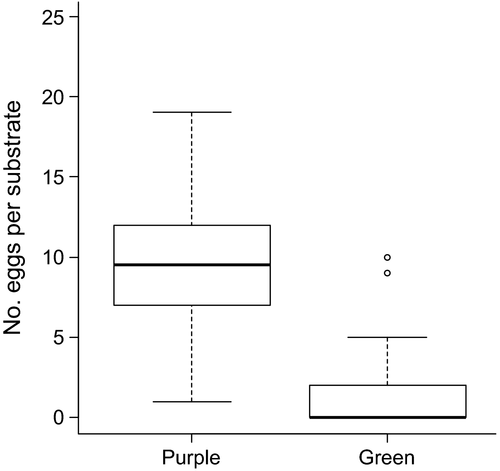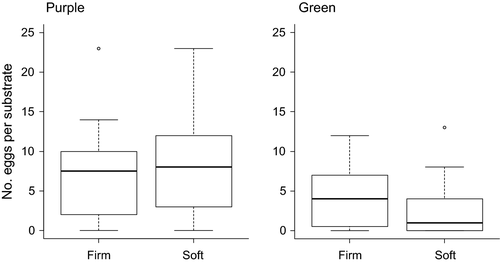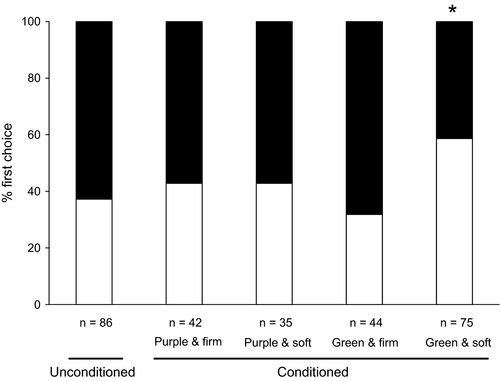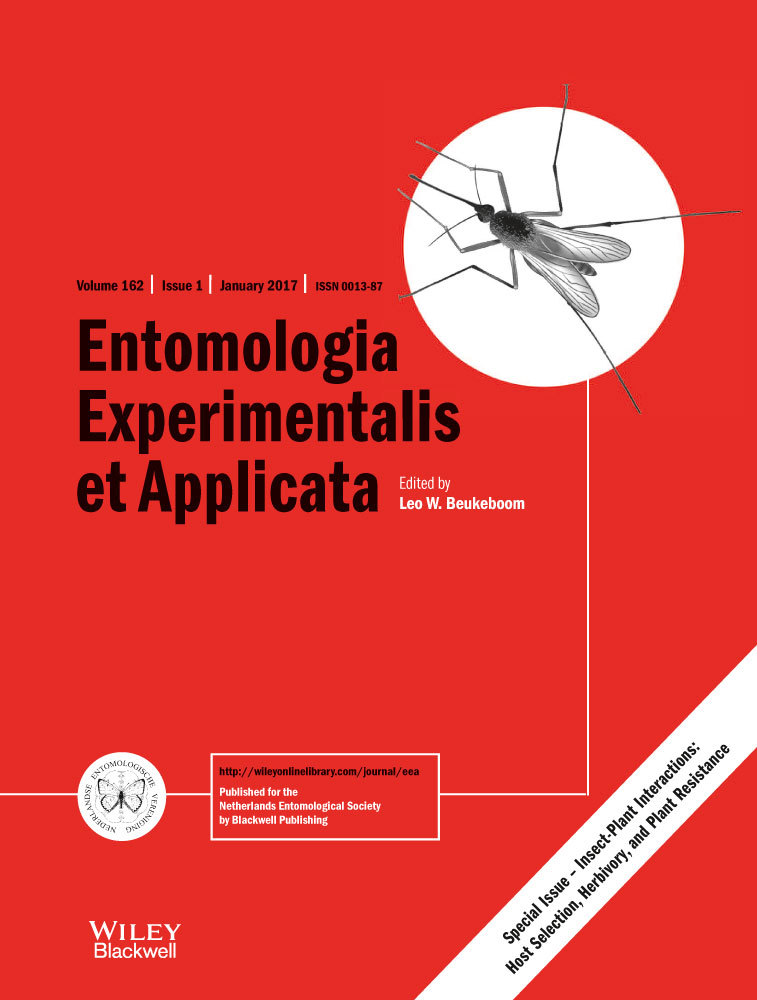Associative learning of color and firmness of oviposition substrates in Drosophila suzukii
Abstract
Drosophila suzukii Matsumura (Diptera: Drosophilidae), also known as the spotted-wing drosophila, is a global pest fly. The degree of infestation of D. suzukii varies greatly among host plants, possibly depending on the physical properties of the fruits. Because some of the physical properties of fruits can only be judged by touching them, D. suzukii may choose to oviposit based on the physical properties of fruits and remote sensory information such as visual cues. Here, we conducted associative learning experiments with artificial substrates consisting of water, cornmeal, fructose, and agarose with different colors and firmness. We assessed associative learning by conditioning flies with combinations of two colors (purple or green) and degrees of firmness (firm or soft), and comparing their choice between the conditioned color and the other color afterward. We demonstrated that D. suzukii had an associative learning ability but it was limited to the association between green and soft. Drosophila suzukii conditioned with green and soft substrate preferred green as the first choice in the test phase. The proximate cause of this asymmetrical associative learning ability is completely unknown, but the pattern of learning coincides with D. suzukii's preference for immature fruits on the tree in nature, possibly to avoid competition with other fruit flies. The associative learning ability of D. suzukii was found to be limited to a certain combination of color and firmness. It suggests that the asymmetrical association of the natural fruit color and physical properties played a role in the evolution of color-specific associative learning ability of D. suzukii.
Introduction
Drosophila suzukii Matsumura (Diptera: Drosophilidae), also known as the spotted-wing drosophila, is a species native to eastern Asian countries including Japan, but has become a pest fly on a global scale (Hauser, 2011). It was detected in 10 states of mainland USA, British Columbia (Canada), and in Europe (Italy, France, and Spain) during 2008–2010 (Lee et al., 2011). The degree of infestation of D. suzukii varies greatly among host plants possibly because of the oviposition preference based on firmness, pH, and sugar content (Brix) of the fruits (Lee et al., 2011; Burrack et al., 2013; Kinjo et al., 2013). Because the physical properties of fruits can only be judged by touching them, D. suzukii may oviposit effectively by associating physical properties of fruits and remote sensory information such as visual cues. However, whether D. suzukii possesses such associative learning ability is unknown.
Learning plays an important role in locating and selecting suitable foods and oviposition sites for a broad range of insects, including nectar feeders, herbivores, and parasitoids (Papaj & Prokopy, 1989; Dukas, 2008). A female butterfly, for example, may use a particular cue, such as color, when foraging for nectar and when searching for a larval host plant (Bernard & Remington, 1991; Weiss, 1995). In fact, the papilionid butterfly Battus philenor (L.) is known to learn the association between the color of flowers and the sugar content of their nectar (Weiss, 1995). In Drosophila melanogaster Meigen, one of the best studied model organisms for learning, adult flies are known to avoid odors associated with electric shock and prefer odors associated with sugar (Quinn et al., 1974; Tempel et al., 1983). Adult D. melanogaster can also learn to avoid distinct colors associated with aversive shock or shaking (Quinn et al., 1974; Folkers, 1982) and avoid visual patterns associated with excessive heat (Wolf & Heisenberg, 1991; Liu et al., 2006). Additionally, adult flies can learn to associate one of the visual stimuli with an appetitive or aversive chemical substance (Schnaitmann et al., 2010). In the case of D. suzukii, it utilizes a wide range of fruits with various colors: green table grapes (green), immature stage of blackberry, raspberry, and blueberry (green), and matured stage of blackberry (black), raspberry (red), and blueberry (purple). Previous laboratory studies showed that D. suzukii laid different numbers of eggs on fruits at various maturation stages and colors (Mitsui et al., 2006; Lee et al., 2011). To locate a target fruit, D. suzukii should use both olfactory and visual cues (Keesey et al., 2015). However, because the spatial resolution of the host fruit search based on olfactory cues might not be high enough for a fly to distinguish mature and immature fruits hanging next to each other, visual cues would be important especially in close proximity. In fact, visual cues such as the shape and color of fruits may determine the ovipositional site for D. suzukii, as they are for other insects (Fletcher, 1987; Harris & Miller, 1988; Renwick & Chew, 1994). Therefore, D. suzukii may also learn the association between color and the physical property of fruits – such as texture, firmness, and surface chemistry – that have potential to affect its oviposition preference. If so, oviposition experience on a fruit may influence the color preference of D. suzukii in the next fruit selection.
Burrack et al. (2013) indicated that the firmness of the substrates is an important physical property that affected the oviposition preference of D. suzukii. Because it is necessary for D. suzukii to touch the surface of the substrate in order to access its firmness, D. suzukii might use a visual cue such as the color of the substrate to infer its firmness to identify suitable oviposition substrates efficiently. In this study, we examined whether D. suzukii is capable of associating the firmness and color of oviposition substrates, and modify its behavior based on experience. We used purple and green artificial substrates to perform associative learning experiments.
Materials and methods
Flies
The HJ strain of D. suzukii was obtained from EHIME-Fly, the laboratory for Drosophila resources at Ehime University (Matsuyama, Japan) and maintained at 23 °C in plastic vials (20 mm diameter, 95 mm long) containing cornmeal-agar fly medium under constant light. The fly medium consisted of water (77.7%), cornmeal (5.7%), inactive dry yeast (2.7%), soy flour (1.6%), agar (0.6%), dried light malt extract (3.6%), dextrose (5.8%), acid mix (1.1%), and nipagin (1.3%). The following experiments were also performed at 23 °C under constant light. Non-virgin females aged between 7 and 14 days after eclosion were used for the following experiments.
Artificial substrates
In a previous study, it was suggested that the high firmness of blueberries negatively influences the oviposition of D. suzukii (Kinjo et al., 2013). Here, we conducted associative learning experiments using artificial substrates of different color and firmness. To mimic the ripening process of blueberry, we used the colors green and purple.
To make artificial substrates consisting of water, cornmeal, fructose, and agarose, we set pH and Brix of the substrate to 3.5 and 13% to reproduce typical pH and sugar content of commercially available blueberries (Miller & McDonald, 1993; Ribera et al., 2010; Vázquez-Araújo et al., 2010; Duan et al., 2011). We measured pH (pH Tester 20; Nikko Hansen, Osaka, Japan) and sugar content (PAL-1 refractometer; Atago, Tokyo, Japan) when the substrates were at liquid state before adding agarose. As for firmness, we set three levels – firm, intermediate, and soft (96, 72, and 48 g mm−2) – by changing the amount of agarose to reproduce average and upper and lower limits of the typical firmness of blueberry fruits determined based on the measurement of 46 commercially available fruits in Japan. Firmness of the artificial substrates was checked with a penetrometer (Fruit hardness tester; Fujiwara Scientific, Tokyo, Japan) with a column plunger (5 mm diameter). When the plunger was pushed into a substrate, the maximum resistance value observed when the plunger penetrated the surface of the substrate was defined as the firmness of the substrate. To make individual substrates with flat surface, 5 ml of the substrate was poured to 3.5-mm-diameter Petri dishes. The substrates were stained by food colorings (My Kitchen, Miyazaki, Japan). Due to the cornmeal, the artificial substrates were not completely odorless, but because the amount of cornmeal was constant among the substrates, we think the level of odor did not confound with the firmness and color. For the colors, we selected the purple that was closest to the color of ripe blueberries and the green that was closest to the immature blueberries by visually comparing the similarity between artificial substrates with different concentrations of the food coloring and the blueberry fruits.
Experimental design
We first examined the oviposition preference of D. suzukii on color and firmness of the artificial substrates. Two artificial substrates were placed 1.5 cm apart on the bottom of a plastic cage (9 cm diameter, 5 cm high), 10 female flies were introduced and kept there for 24 h, and then the eggs laid in the substrates were counted. To examine the oviposition preference for color, we used purple and green substrates with intermediate firmness. To examine oviposition preference for firmness, D. suzukii were given a choice between a high and low firmness substrate within a given color.
We then assessed associative learning by conditioning flies with one of the four sets of colors and degrees of firmness, and comparing their choice between the conditioned color vs. the other color. The assay consisted of two phases. During the conditioning phase (12 h), flies were kept individually in each of the plastic cage, and experienced a green or a purple and firm or soft medium in the plastic cage. Only the flies that were confirmed to lay at least one egg in 12 h of the conditioning phase were used for the next experiment. The conditioning phase was immediately followed by the test phase (first choice assay), in which each fly could choose between two substrates placed 1.5 cm apart on the bottom of the plastic cage, one stained with purple and one with green. As a control treatment, we used unconditioned flies that were maintained on standard cornmeal-agar medium with no food coloring before the test phase. The firmness of the substrates used in the test phase was set to the intermediate level. We recorded the first substrate that the female chose to land on as its first choice.
Statistical analysis
Oviposition preference on color and firmness was tested with logistic regression analysis using the numbers of eggs laid on the two substrates as objective variable, and the intercept as a constant term. The analyses were performed separately for each experiment. The numbers of the first choice for purple and green substrates under conditioning treatments were compared with those under the control treatment using Fisher's exact test. To adjust for the multiple comparisons when assessing the statistical significance, we applied the Bonferroni correction. All analyses were conducted with R v.3.1.3 (www.r-project.org).
Results
When the flies did not experience the conditioning phase, they tended to lay more eggs on the purple substrate (n = 40, P<0.0001; Figure 1), indicating their innate color preference for purple over green. When we examined the oviposition preference for firmness using purple and green substrates, the flies showed no preference for firmness in either color (purple: n = 14, P = 0.26; green: n = 11, P = 0.098; Figure 2). The flies conditioned with purple substrates did not show a change in color preference in the test phase (purple & firm: P = 0.57; purple & soft: P = 0.68) and maintained preference for purple (Figure 3). The flies conditioned with green and firm substrates maintained the innate color preference for purple (P = 1 after Bonferroni correction) whereas the flies conditioned with green and soft substrates displayed a change in color preference (P = 0.030 after Bonferroni correction) and now preferred green over purple (Figure 3).



Discussion
Drosophila suzukii showed innate color preference for purple over green in this study. Such color preference was expected from the studies on the oviposition preference of D. suzukii using blueberries at different maturation stages (Lee et al., 2011). Kirkpatrick et al. (2016), however, found that D. suzukii displayed no significant difference in the degrees of preference for purple and green disks based on multiple choice experiment. The discrepancy between the current study and Kirkpatrick et al. (2016) may come from the substrates used in the preference experiments. Kirkpatrick et al. (2016) colored odorless disks to eliminate the effect of olfactory stimulus, whereas the artificial substrates used in our study were not completely odorless because of the cornmeal. The color preference of D. suzukii might differ depending on the olfactory stimulus presented together with the visual stimulus. In addition to that, in the current study, the innate color preference was examined using unconditioned flies that did not go through a conditioning phase, but instead they were maintained in yellowish rearing media. Experiencing the yellowish color right before the color preference trial might have affected the color preference for purple observed in this study. Also the difference in shape and texture of the substrates and the shades of purple and green tested might contribute to the difference between Kirkpatrick et al. (2016) and the current study.
In the choice experiment using substrates with the same color (purple or green) and different firmness (high or low), D. suzukii did not display significant oviposition preference on firmness. This result contradicts the result of Burrack et al. (2013), where firmness affected the oviposition preference of D. suzukii significantly. The discrepancy between the current study and Burrack et al. (2013) might be due to the difference in odor and texture of the substrates resulting from the different ingredients.
In this study, we demonstrated that D. suzukii was capable of associative learning but it was limited to the association between the color green and low firmness. Drosophila suzukii conditioned with green and low firmness substrate preferred green as the first choice in the test phase. Drosophila suzukii's innate color preference for purple and color variation in fruits in general may explain the pattern of associative learning observed in this study. Besides blueberry, many fruits change their color from green to purple along with maturation. Therefore, D. suzukii may not have to learn to associate the purple color of the fruits with a physical property such as firmness. The green of fruits, however, does not necessarily mean that the fruits are immature because some fruits such as grapes mature in green. Additionally, some of the green immature stages of fruits that turn into black or purple when they mature may be available for D. suzukii to oviposit. It might be adaptive for D. suzukii to be able to learn to associate the green of fruits with a physical property such as firmness to identify fruits at favorable maturation stages. The associative learning that we observed may help D. suzukii to oviposit in such green fruits. No significant preference for low firmness was observed when D. suzukii was given two substrates with the same color, suggesting that the information on the low firmness of the substrates influences the behavior of D. suzukii only when it is combined with the color green. The proximate cause of this asymmetrical associative learning ability is completely unknown, but the pattern of the learning coincides with D. suzukii's preference for immature fruits on the tree in nature possibly to avoid competition with other fruit flies feeding on fallen fruits. Drosophila melanogaster is known to associate one of the two visually conditioned stimuli with an appetitive or aversive chemical substance (Schnaitmann et al., 2010). Drosophila suzukii's associative learning ability found in the current study, on the other hand, was very limited. It may suggest that the asymmetrical association of the natural fruit color and physical properties (firmness of green fruits ranges from soft to hard whereas purple fruits are soft in most cases) played a role in the evolution of color-specific associative learning ability of D. suzukii.
Results of the current study suggest associative learning ability of D. suzukii. This indicates that D. suzukii has a potential to associate favorable physical properties of fruits with their color to oviposit efficiently, and this association could be updated if D. suzukii utilizes a new fruit for a long enough time. This associative learning ability may be one of the key factors that allow D. suzukii to damage a wide range of fruit species with diverse colors effectively. Further studies on the associative learning of D. suzukii may lead to a better understanding of its oviposition behavior.




